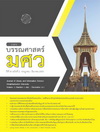สารสนเทศของสถานีโทรทัศน์ในประเทศไทย: กรณีศึกษาสถานีวิทยุโทรทัศน์แห่งประเทศไทยและ องค์การกระจายเสียงและแพร่ภาพสาธารณะแห่งประเทศไทย
Main Article Content
Abstract
การวิจัยนี้มีวัตถุประสงค์เพื่อ 1) ศึกษาสภาพวัฒนธรรมสารสนเทศของสถานีโทรทัศน์เพื่อสาธารณะในประเทศไทย 2) เปรียบเทียบวัฒนธรรมสารสนเทศของสถานีโทรทัศน์เพื่อสาธารณะในประเทศไทยและต่างประเทศ 3) ศึกษาปัจจัยที่มีอิทธิพลต่อวัฒนธรรมสารสนเทศของสถานีโทรทัศน์เพื่อสาธารณะในประเทศไทย และ 4) พัฒนากรอบวัฒนธรรมสารสนเทศที่เหมาะสมสำหรับสถานีโทรทัศน์ในประเทศไทย กรณีศึกษาสถานีวิทยุโทรทัศน์แห่งประเทศไทยและองค์การกระจายเสียงและแพร่ภาพสาธารณะแห่งประเทศไทย วิธีการวิจัยเป็นการวิจัยแบบผสมผสาน กลุ่มตัวอย่างจำนวน 233 คน คัดเลือกแบบเจาะจงตามโครงสร้างองค์กรจากผู้บริหารและผู้ปฏิบัติงานของสถานีโทรทัศน์เพื่อสาธารณะจำนวน 2 แห่งคือสถานีวิทยุโทรทัศน์แห่งประเทศไทย จำนวน 114 คน และองค์การกระจายเสียงและแพร่ภาพสาธารณะแห่งประเทศไทย จำนวน 119 คน เครื่องมือที่ใช้ในการวิจัย ได้แก่ แบบสอบถามและแบบสัมภาษณ์เชิงลึกแบบมีโครงสร้าง การวิเคราะห์ข้อมูลเชิงปริมาณใช้การวิเคราะห์ ค่าร้อยละ ค่าเฉลี่ย ส่วนเบี่ยงเบนมาตรฐาน ส่วนข้อมูลเชิงคุณภาพใช้การวิเคราะห์เนื้อหาแบบอุปนัย ผลการวิจัยพบว่า 1) สภาพวัฒนธรรมสารสนเทศของสถานีโทรทัศน์เพื่อสาธารณะในประเทศไทยเป็นวัฒนธรรมสารสนเทศแบบเป็นทางการที่มีการใช้สารสนเทศจากแหล่งสารสนเทศภายในองค์กรมากกว่าภายนอกองค์กร มีวัฒนธรรมองค์กรแบบราชการที่เน้นความเป็นระเบียบแบบแผน ยึดกฎระเบียบเคร่งครัด 2) วัฒนธรรมสารสนเทศของสถานีโทรทัศน์เพื่อสาธารณะในประเทศไทยมีความเหมือนกับวัฒนธรรมสารสนเทศของสถานีโทรทัศน์เพื่อสาธารณะในต่างประเทศคือเป็นวัฒนธรรมสารสนเทศแบบเป็นทางการ มีการใช้สารสนเทศตามผังรายการและมีหน่วยงานที่รับผิดชอบด้านการจัดการสารสนเทศ และมีความแตกต่างกันคือในต่างประเทศมีนโยบายด้านสารสนเทศ และข้อกำหนดด้านมาตรฐานการจัดการสารสนเทศและมาตรฐานการลงรายการทรัพยากรสารสนเทศทางโทรทัศน์ 3) ปัจจัยที่มีอิทธิพลต่อวัฒนธรรมสารสนเทศของสถานีโทรทัศน์เพื่อสาธารณะ ได้แก่ นโยบายและโครงสร้างองค์กร ประสบการณ์ของบุคลากร ความทันสมัยของเทคโนโลยีสารสนเทศ และความตระหนักในจริยธรรมวิชาชีพ และ 4) กรอบวัฒนธรรมสารสนเทศที่เหมาะสมสำหรับสถานีโทรทัศน์เพื่อสาธารณะในประเทศไทย ประกอบด้วยวัฒนธรรมองค์กรที่เน้นความคิดสร้างสรรค์และนวัตกรรม และวัฒนธรรมสารสนเทศแบบนวัตกรรมที่มีสภาพแวดล้อมแบบเปิด พร้อมรับการเปลี่ยนแปลงอย่างต่อเนื่อง This research aimed to 1) study the status of the information culture at Thai public television stations; 2) compare the information culture between Thai public television stations and abroad; 3) study the factors affecting information culture at Thai public television stations; and 4) develop an information culture framework for Thai television stations; specifically for the National Broadcasting Services of Thailand and Thai Public Broadcasting Service. This study employed mixed methods of research. The sample group were 233 mass media specialists who work at the administrative and support levels of 2 public television stations: 114 from the National Broadcasting Services of Thailand and 119 from Thai Public Broadcasting Services. Purposive sampling from organizational structure was used to select the sample. The instruments used were questionnaires and structured interviews. The quantitative data was analyzed using percentage, mean, and standard division. The qualitative data was analyzed by using inductive content analysis. The research findings were as follows. 1) Regarding the status of information culture in Thai public television stations, formal information culture mostly uses internal information rather than external information. Organizational culture in Thai public television stations is bureaucratic in that it emphasizes government rules and mounting style for operations. 2) Due to the information culture, there was similarity between Thai public television stations and those abroad in using information given by the television program and specific units for information management. There were differences in that Thai public television stations have less inclusive information than stations abroad which often have a written information policy with an information management plan and television metadata standards. 3) The factors affecting information culture were information policy and information organization structure, work experience, modern information technology and the awareness of professional ethics. 4) The appropriate information culture framework for Thai public television stations would consist of two components: an advocacy culture emphasizing creativity, and an innovation and innovative information culture emphasizing critical thinking skills in an open environment and change management.
Downloads
Download data is not yet available.
Article Details
How to Cite
จันทร์ลุน จ., วิภาวิน น., ครุจิต ว., & ภูภราดัย ก. (2018). สารสนเทศของสถานีโทรทัศน์ในประเทศไทย: กรณีศึกษาสถานีวิทยุโทรทัศน์แห่งประเทศไทยและ องค์การกระจายเสียงและแพร่ภาพสาธารณะแห่งประเทศไทย. บรรณศาสตร์ มศว, 10(2). Retrieved from https://ejournals.swu.ac.th/index.php/jlis/article/view/9953
Section
Research Articles
